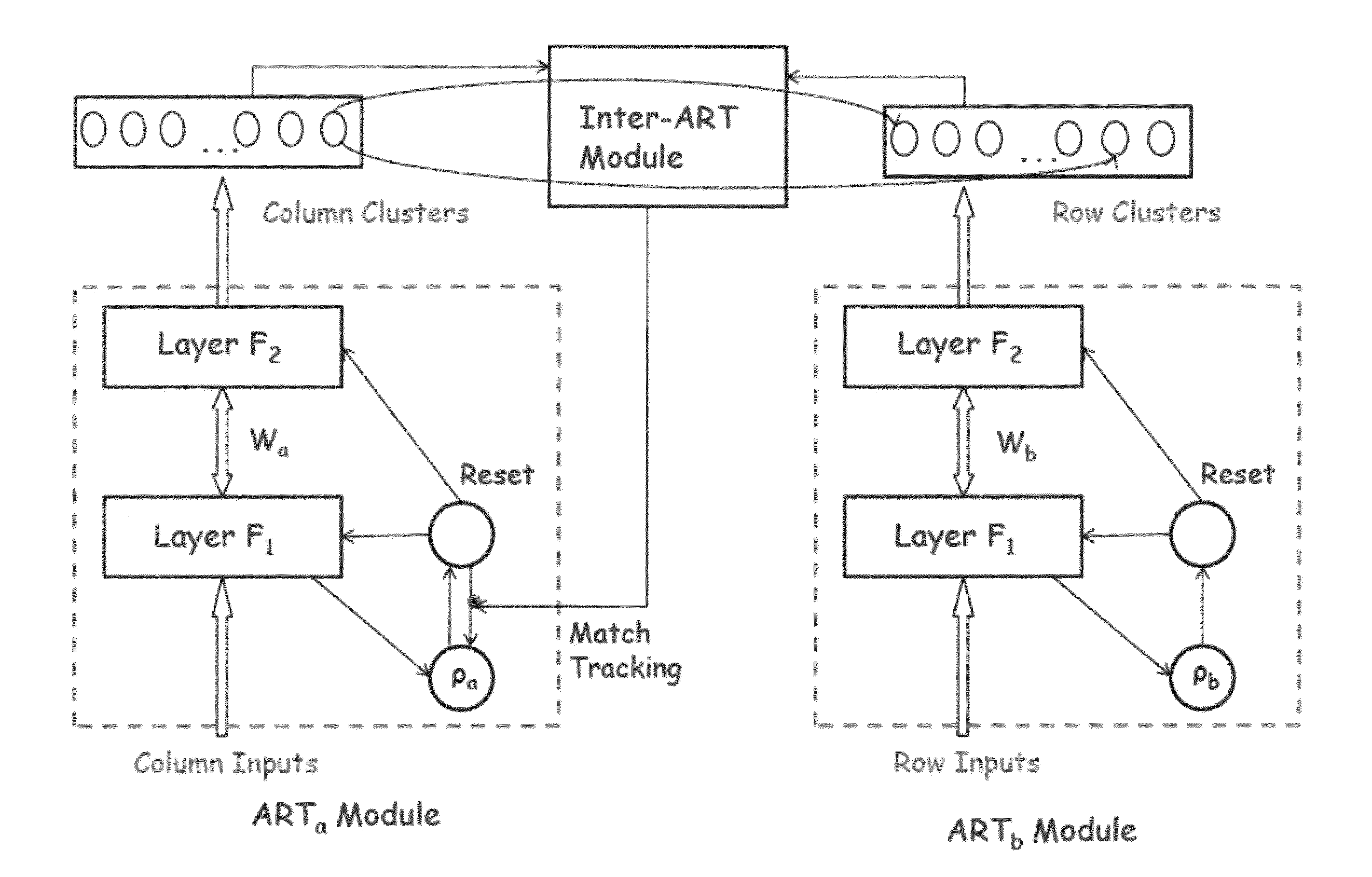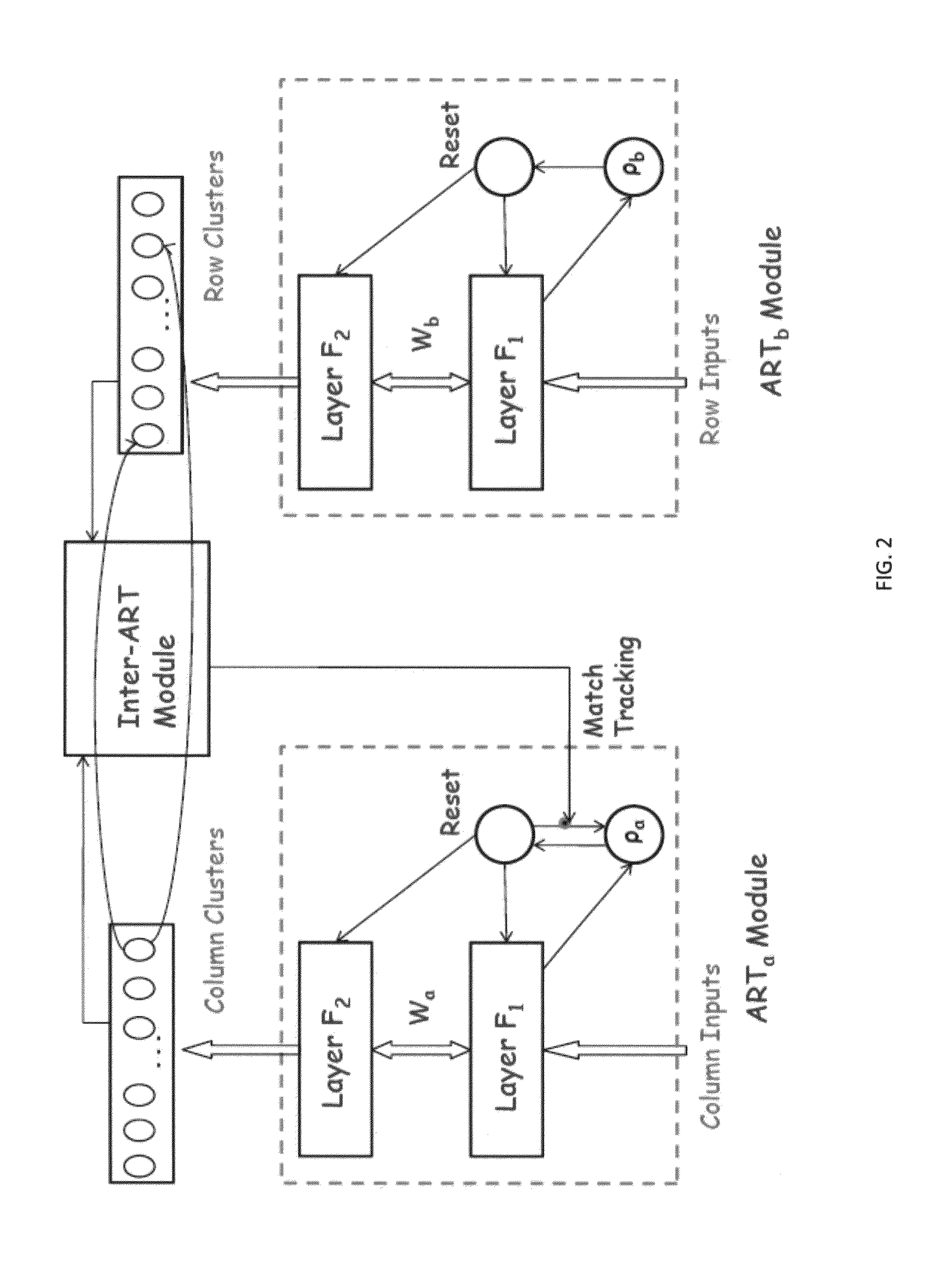Methods and systems for biclustering algorithm
a biclustering algorithm and method technology, applied in the field of data integration and analysis methods, can solve the problems of unsupervised learning algorithms, inability to analyze quantitative data, and inability to apply them in real time, and achieve the effect of improving speed and high quality
Active Publication Date: 2012-08-30
UNIVERSITY OF MISSOURI
View PDF3 Cites 9 Cited by
- Summary
- Abstract
- Description
- Claims
- Application Information
AI Technical Summary
Benefits of technology
[0006]Embodiments of the present invention provide a neural-based classifier that can be modified to perform biclustering in an efficient way. Experimental results on multiple human cancer data sets show that the inventive method with the improved algorithm can achieve clustering structures with higher qualities than or compared to those with other commonly used biclustering or clustering algorithms with significantly improved speed.
Problems solved by technology
There are numerous areas where the quantity of data does not lend itself to human analysis.
These algorithms are unsupervised learning algorithms that are executed to extract knowledge from the data.
However, such a practice is inherently limited due to the existence of many uncorrelated genes with respect to sample or condition clustering, or many unrelated samples or conditions with respect to gene clustering.
In an example of a method the building the local relationships is unsupervised.
In an example, the method may include unsupervised building of the local relationships.
However, the NP-complete computational complexity raises a great challenge to computational methods to find such local relations.
However, if the neuron is uncommitted, the input pattern cannot be classified solely based on prior experience.
However, typical approaches have NP-complete computational complexity, which raises a great challenge to computational methods for identifying such local relations.
However such a practice is inherently limited because according to our general understanding of cellular processes, only a subset of genes is involved with a specific cellular process, which becomes active only under some experimental conditions, while microarrays are generally not specifically designed to meet the requirements of an experiment of interest.
In this case, the inclusion of all genes in sample clustering or all samples in gene clustering not only increases the computational burden, but could impair the clustering performance due to the effect of these unrelated genes or samples, which are treated as noise.
As the computational complexity for its ART modules is P(NlogN) or O(N) for one pass variant (Mulder & Wunsch, 2003), the overall computational cost for BARTMAP is relatively low.
This ability contrasts with other, opaque neural network architectures for which it is generally difficult to explain why an input produces a particular output.
There may be constraints in using a GPU, for example, direct memory access between the host processor (CPU) and the graphic processor (GPU) is not possible and thus to handle certain data in other sides, data transfer is required either from CPU to GPU or vice versa.
The lack of dynamic pointer and array generation inside the kernel may limit the GPU.
However, these methods are not used in a kernel lever.
But as the depth grows to meet a certain value, the performance of the GPU implementation exceeds that of the CPU application.
Inflexibility in this context may mean that the generation of dynamic arrays are limited only in the host (CPU) side.
A further difficulty that may be overcome in this example is that typical tree structure algorithms implement pointers for both node creation and reference, which is inefficient to do in CUDA programming.
However, typical approaches have NP-complete computational complexity, which raises a great challenge to computational methods for identifying such local relations.
Method used
the structure of the environmentally friendly knitted fabric provided by the present invention; figure 2 Flow chart of the yarn wrapping machine for environmentally friendly knitted fabrics and storage devices; image 3 Is the parameter map of the yarn covering machine
View moreImage
Smart Image Click on the blue labels to locate them in the text.
Smart ImageViewing Examples
Examples
Experimental program
Comparison scheme
Effect test
case 1
[0049] xi and xj belong to the same clusters of C and the same category of P.
case 2
[0050] xi and xj belong to the same clusters of C but different categories of P.
case 3
[0051] xi and xj belong to different clusters of C but the same category of P.
the structure of the environmentally friendly knitted fabric provided by the present invention; figure 2 Flow chart of the yarn wrapping machine for environmentally friendly knitted fabrics and storage devices; image 3 Is the parameter map of the yarn covering machine
Login to View More PUM
 Login to View More
Login to View More Abstract
Methods and systems for improved unsupervised learning are described. The unsupervised learning can consist of biclustering a data set, e.g., by biclustering subsets of the entire data set. In an example, the biclustering does not include feeding know and proven results into the biclustering methodology or system. A hierarchical approach can be used that feeds proven clusters back into the biclustering methodology or system as the input. Data that does not cluster may be discarded. Thus, a very large unknown data set can be acted on to learn about the data. The system is also amenable to parallelization.
Description
[0001]The present application claims benefit of U.S. Provisional Application No. 61 / 462,121 (Docket No. 11MST001PRV, Express Mail Label No. EG 477472577 US), filed 28 Jan. 2011, and titled Fast Biclustering Algorithm, which is hereby incorporated by reference for any purpose.GRANT STATEMENT[0002]This invention was made with government support under Award Numbers: 0725382 and 0836017 awarded by National Science Foundation. The government has certain rights in the invention.FIELD[0003]This application relates generally to a data integration and analysis method, more specifically, to a high throughput data integration and analysis method based on biclustering or clustering algorithms for research that has significant quantity of data such as biological or biomedical research.BACKGROUND[0004]Clustering is a data analysis technique that can assist in extracting knowledge from data sets. Clustering can be thought of generally as a process of organizing objects into groups whose members ar...
Claims
the structure of the environmentally friendly knitted fabric provided by the present invention; figure 2 Flow chart of the yarn wrapping machine for environmentally friendly knitted fabrics and storage devices; image 3 Is the parameter map of the yarn covering machine
Login to View More Application Information
Patent Timeline
 Login to View More
Login to View More IPC IPC(8): G06F17/30G16B40/30
CPCG06F19/24G06F17/30539G06F16/2465G16B40/00G16B40/30
Inventor WUNSCH, II, DONALD COOLIDGEXU, RUIKIM, SEJUN
Owner UNIVERSITY OF MISSOURI
Features
- R&D
- Intellectual Property
- Life Sciences
- Materials
- Tech Scout
Why Patsnap Eureka
- Unparalleled Data Quality
- Higher Quality Content
- 60% Fewer Hallucinations
Social media
Patsnap Eureka Blog
Learn More Browse by: Latest US Patents, China's latest patents, Technical Efficacy Thesaurus, Application Domain, Technology Topic, Popular Technical Reports.
© 2025 PatSnap. All rights reserved.Legal|Privacy policy|Modern Slavery Act Transparency Statement|Sitemap|About US| Contact US: help@patsnap.com



